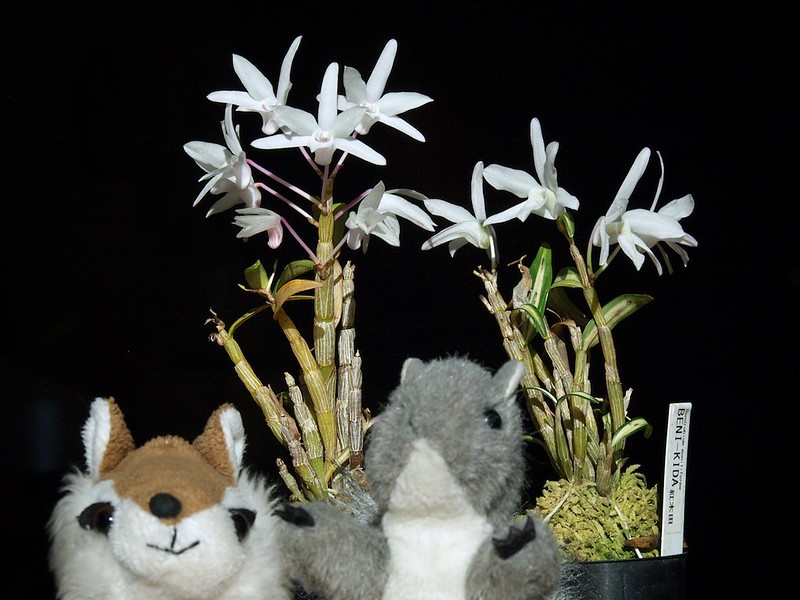 |
| Benikomachi (紅小町, left), Benikida (紅木田, right), and my son's friends. |
Dendrobium moniliforme is native to Japan (link to distribution map) and has been grown for a long time in Japan. Japanese common name is Sekkoku. Some of them with desirable features are called Chouseiran (長生蘭), which translates to a "long-living orchid". Technically, Chouseiran are the varieties which are formally registered with Nihon Chouseiran Rengoukai (日本長生蘭連合会), which roughly translates to Japan Chouseiran Association. They publish yearly "ranking" (Meikan). This means that you can't simply say that Chouseiran is the variegated forms of D. moniliforme.
Cultivation of this species has been popular because there are large variations in variegation, plant sizes, flower shapes, flower color, and pseudobulb morphology among regions and cultivars. Many of them are fairly easy to cultivate, and they are relatively affordable.
The home I grew up had beautiful Japanese garden landscaped by my father, grand-father, and probably several generations before him. On the center piece boulder, I remember sorry looking twigs were attached, which have some leaves in the summer. We didn't particularly pay attention to this D. moniliforme, but it just survived there. I'm not sure how long it has been there. I have been growing (or living with) orchids on and off for almost all my life, but I've never grown this species until recently. I probably had an impression that it is a common "weed". But after being a father, a lot of childhood memory started to come back whenever I'm having fun with my wonderful son. Probably, this revival of my childhood memory is a part of reason I started to learn and look for more Japanese orchids.
Here, I'm showing two varieties with Nakafu (中斑), which is the pattern with white (or yellow) in the middle and green around the edge of the leaves. These two varieties are easily available, and are considered as beginner varieties. I got these from Seed-engei, who specializes on Japanese orchids. If you are interested, you should be included in her email list (the web site is usually out-of-date).
Benikida (紅木田) is a medium size plant, with relatively narrow leaves with shiro-nakafu (white central variegation). When the leaves are fresh, they show beautiful pink/purple color in the middle, but it disappears later. This red coloring in the leaves is called Beniguma (紅隈, see a photo of Benikomachi below). The flower is white with a touch of very pale pink. The oldest remaining literature about the culture of D. moniliforme in Japan is Chouseisou (長生草) written by Mr. Higuchi (樋口), the owner of Akio-tei (秋尾亭) in 1835. Akio-tei was a nursery in Kyoto. This literature described 55 varieties, and Benikida was one of them. Some people say that the original Benikida doesn't exist anymore, and what we call Benikida may be different from the one described in 1835. The color of pseudobulb/cane (referred as "Ya" in Japan) is greenish (Midori-Jiku; 緑軸, green axis), but older pseudobulb is more brownish (Doro-jiku; 泥軸, which means "muddy color axis"). When the pseudobulb becomes golden yellow, this feature (Gei) is called Ameya (candy cane), and the variety name becomes Kintsuru (金鶴). I heard that this change occurs fairly frequently.
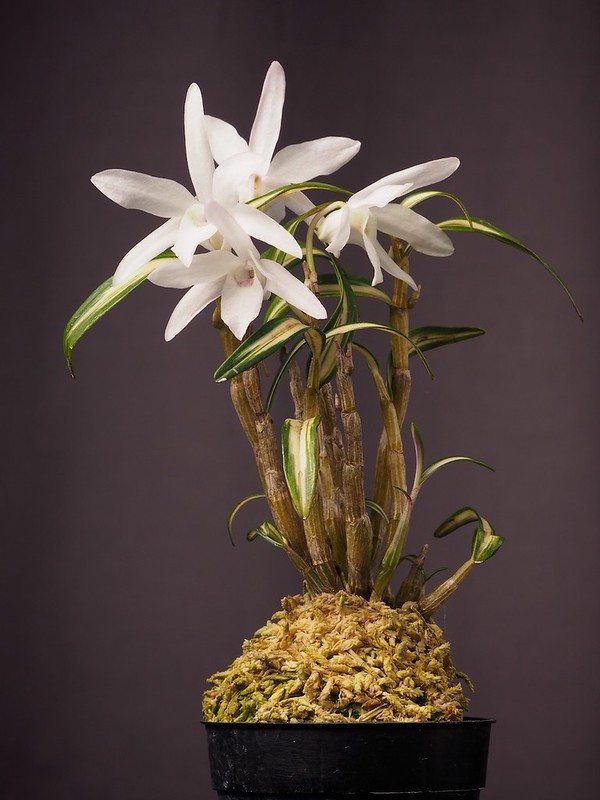
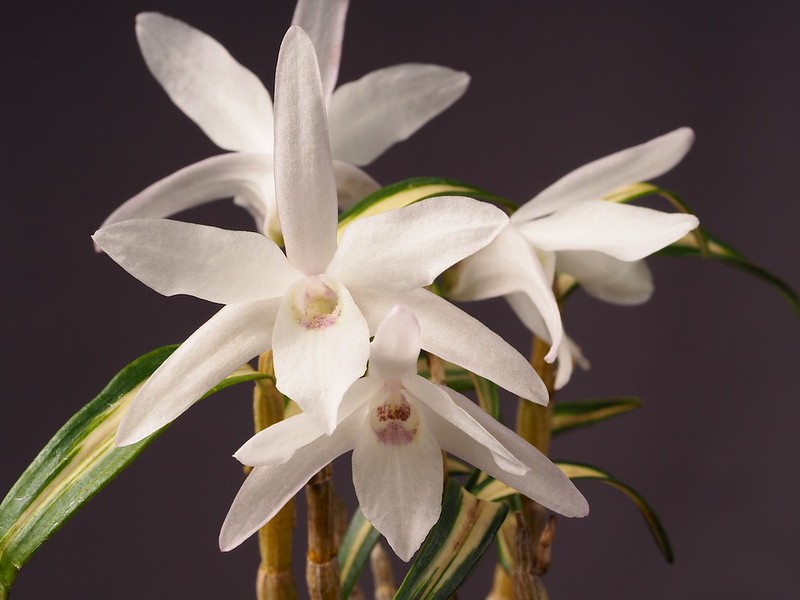
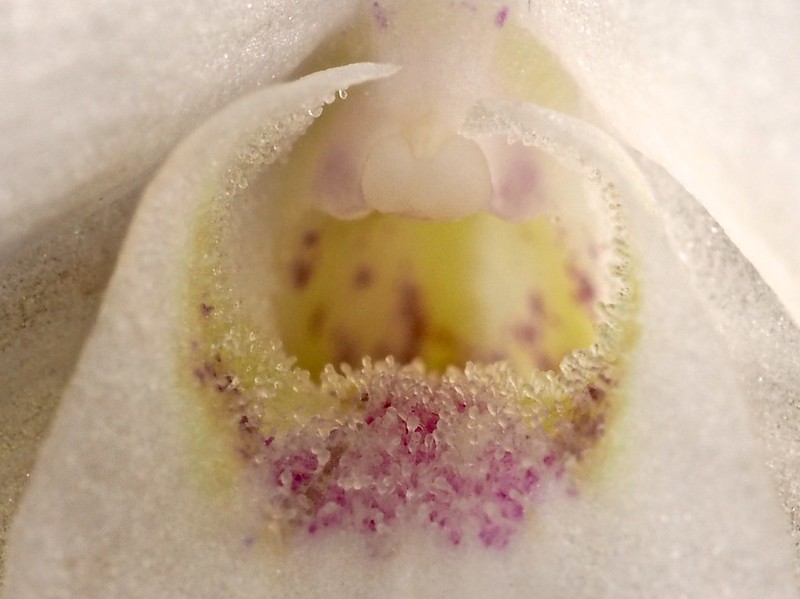
Benikomachi (紅小町) is also an old variety. It was mentioned in 1884. The feature of this variety is also shiro-nakafu. When the pseudobulb is new, it shows Ameya (golden color), but the color darkens as the pseudobulb matures, and it becomes more like Doro-jiku (brownish pseudobulb). The flower also has a touch of pink. This variety is supposed to be derived from Umegae (梅ヶ枝), which had Doro-jiku instead of Ameya. Umegae was mentioned in 1835. A knowledgeable person in Japan mentioned that there appear to be two lineages of Umegae; one with white variegation and the other with more creamy white variegation. The white lineage appears to have a higher tendency to develop Ameya than the creamy lineage. Interestingly, Umegae is less available than Benikomachi because this change to Ameya is frequent. When the pseudobulbs don't become darker as they mature (i.e. they remain golden colored), it is called Benifuuki (紅富貴). Another variety, Houou (鳳凰), derived from Benikomachi, also shows Ameya which doesn't darken, but the red coloring on the leaf (Beniguma) shows strongly in fall. Komaachi-musume (小町娘), derived from Benikomachi has following differences; the color of variegation becomes more yellow, leaf surface becomes rough like rasp, and the leaves become rounder and thicker. So there are lots of variation derived from Umegae.
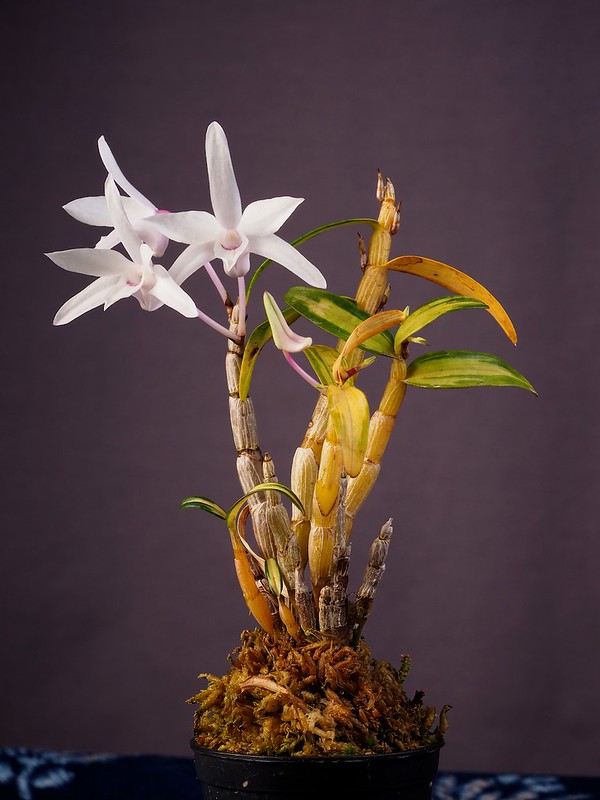
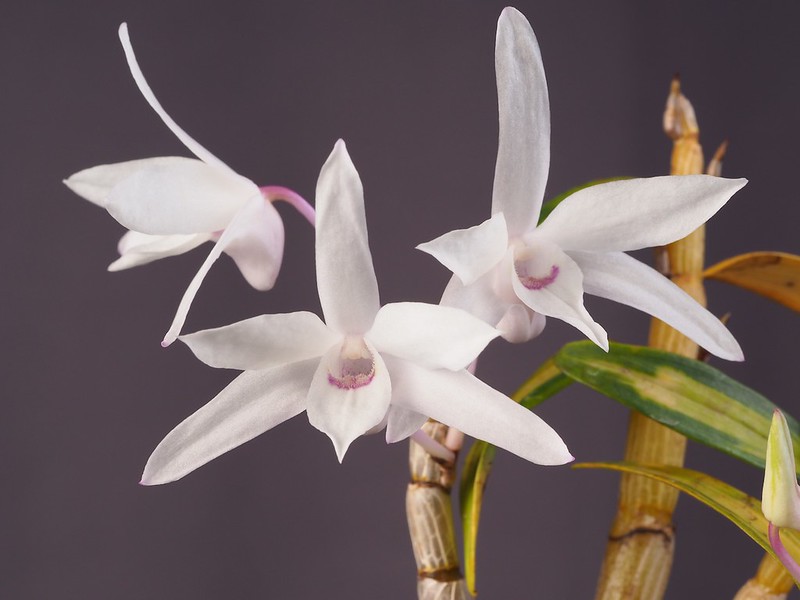
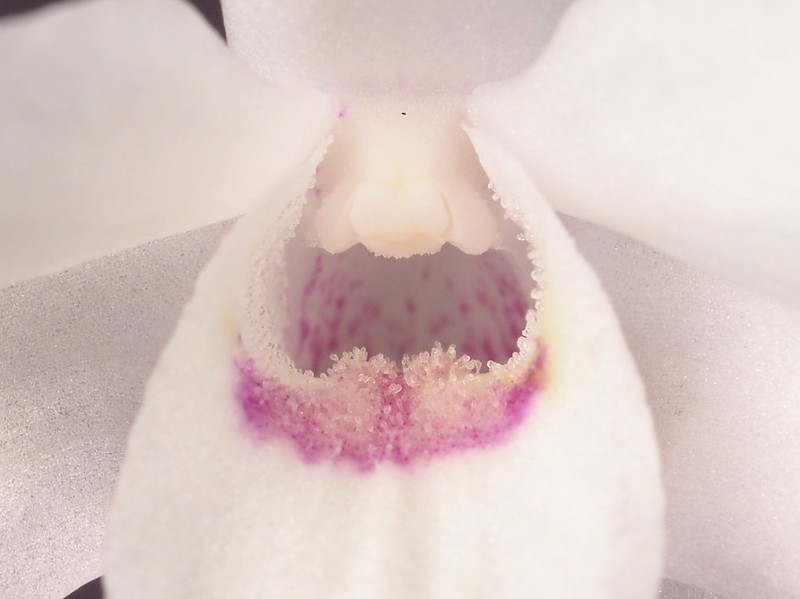
You can see the red coloring on the new leaves. This is called Beniguma (紅隈). Also you can see the younger pseudobulbs have lighter color (right most), and older ones (in the middle front) have darker color.

The fun part of D. moniliforme is that it keeps changing in the short and long time scale. Within a season, you can see red color on the leaves, changing color of pseudobulbs and even the color of variegation changes. In a longer term, when new pseudobulbs are coming up, the feature could change either by chance or due to culture. So it is always exciting to see the new pseudobulb or even a new leaves. This is especially true for the varieties with leaf variegation, and you can enjoy the orchid for the entire year in addition to flowering in the spring. For this reason, varieties with leaf variation seems to be more popular than the flower variation in Japan. This is somewhat connected to Japanese culture since seasonal change is highly appreciated. For example, one of the themes of Haiku (Japanese poem is capturing the subtle changes of season and flow of time by a couple words. In the US, people seem to put more emphasis in flower variation, at least when they are starting with this species. Vanda (Neofinetia) falcata is becoming more and more popular all over the world for the similar reason. But I feel that D. moniliforme shows more dramatic seasonal changes.
I'm still a beginner with this species, and the information presented here is gathered from internet search (mostly from Japanese sites). So please don't hesitate to point out my mistake if you find wrong information here. With the variegated varieties, the flower is rather secondary, and growers try to get nice presentation of the leaves. As you can see here, I still don't know how to get the nice long lasting leaves, so there are lots of things I need to learn!
Comments
Post a Comment